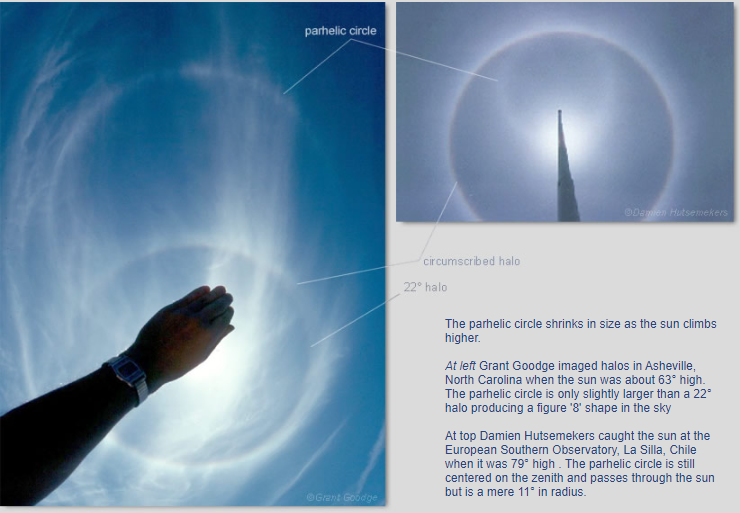Parhelic Circle - High Sun
Parhelic Circle - High Sun
The phenomenon of the parhelic circle, a circular halo that appears in the sky, undergoes changes in size and shape as the sun climbs higher. As the sun ascends, the parhelic circle gradually shrinks in size, creating captivating patterns in the atmosphere. This article explores the characteristics and visual effects of the parhelic circle when the sun is positioned at higher altitudes.
When the sun reaches an elevation of approximately 63°, the parhelic circle becomes slightly larger than a 22° halo, resulting in a distinctive figure '8' shape in the sky. Grant Goodge managed to capture this phenomenon in Asheville, North Carolina, where the parhelic circle exhibited its intriguing form. The parhelic circle remains centered on the zenith and passes through the sun, with a radius of around 11°.
At the European Southern Observatory in La Silla, Chile, Damien Hutsemekers observed the parhelic circle when the sun was even higher, approximately 79° above the horizon. Even at this greater altitude, the parhelic circle retained its position centered on the zenith and passing through the sun. However, due to the increased height of the sun, its radius reduced further to a mere 11°.
The shrinking size of the parhelic circle as the sun climbs higher can be attributed to the changing geometry of light refraction and reflection in the atmosphere. The varying angles at which sunlight interacts with ice crystals in the air result in alterations to the halo's appearance. These changes can produce mesmerizing visual effects that captivate observers.
To fully appreciate the parhelic circle when the sun is high, it is essential to understand its formation process. The parhelic circle is formed by sunlight refracting and reflecting off hexagonal ice crystals present in cirrus clouds or diamond dust close to ground level. As light passes through these ice crystals, it is bent and dispersed, creating the circular halo effect.
The intricate nature of the parhelic circle when the sun is high makes it a captivating sight for sky enthusiasts and photographers alike. The figure '8' shape and the diminishing size of the halo add an extra layer of complexity to the atmospheric optics phenomenon. Observers can marvel at the interplay between light and ice crystals, as well as the ever-changing patterns painted across the sky.
In addition to the parhelic circle, other atmospheric optical phenomena may also be visible when the sun is high in the sky. These include sundogs, tangent arcs, and circumzenithal arcs, all of which contribute to the breathtaking display of colors and shapes that can occur in the upper atmosphere. The combination of these phenomena creates a spectacle that showcases the wonders of nature.
As with many atmospheric optics phenomena, capturing the parhelic circle at its best requires favorable conditions. Clear skies, the presence of cirrus clouds or diamond dust, and proper positioning of the observer in relation to the sun are crucial factors. Patience and a keen eye are often rewarded with the opportunity to witness and photograph these elusive atmospheric displays.
In conclusion, the parhelic circle undergoes intriguing changes in size and shape as the sun climbs higher in the sky. From its figure '8' appearance when the sun is around 63° high to its significantly reduced radius at approximately 79°, the parhelic circle showcases the intricate dance between light and ice crystals in the atmosphere. Sky enthusiasts and photographers can revel in the beauty of this phenomenon, alongside other atmospheric optical displays that may accompany it.

The parhelic circle shrinks in size as the sun climbs higher.
At left Grant Goodge imaged halos in Asheville, North Carolina when the sun was about 63° high. The parhelic circle is only slightly larger than a 22° halo producing a figure '8' shape in the sky
At top Damien Hutsemekers caught the sun at the European Southern Observatory, La Silla, Chile when it was 79° high . The parhelic circle is still centered on the zenith and passes through the sun but is a mere 11° in radius.
Note: this article has been automatically converted from the old site and may not appear as intended. You can find the original article here.
Reference Atmospheric Optics
If you use any of the definitions, information, or data presented on Atmospheric Optics, please copy the link or reference below to properly credit us as the reference source. Thank you!
-
<a href="https://atoptics.co.uk/blog/parhelic-circle-high-sun/">Parhelic Circle - High Sun</a>
-
"Parhelic Circle - High Sun". Atmospheric Optics. Accessed on December 21, 2024. https://atoptics.co.uk/blog/parhelic-circle-high-sun/.
-
"Parhelic Circle - High Sun". Atmospheric Optics, https://atoptics.co.uk/blog/parhelic-circle-high-sun/. Accessed 21 December, 2024
-
Parhelic Circle - High Sun. Atmospheric Optics. Retrieved from https://atoptics.co.uk/blog/parhelic-circle-high-sun/.